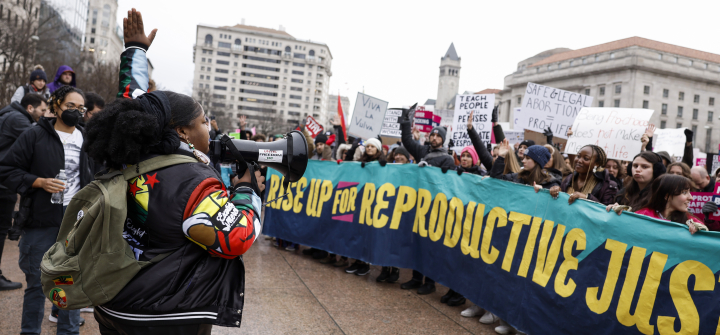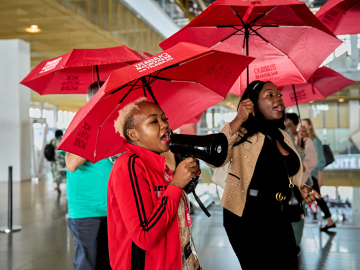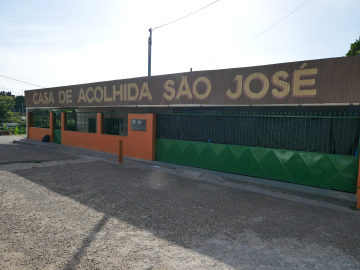Reproductive Risks and Rights in the Age of Dobbs
In post-Roe America, the potential overturn of the FDA’s approval of the abortion medication mifepristone looms as the latest threat to abortion access—jeopardizing telemedicine advances that helped make self-managed abortions a reality even for women living in areas where abortion is severely restricted.
Abortion medications are very safe, said Dutch physician and activist Rebecca Gomperts. It is the criminalization of the drugs that puts providers—and the most vulnerable people—at risk in the wake of the Supreme Court’s Dobbs v. Jackson Women’s Health Organization decision last summer, she said, speaking at a seminar on reproductive rights Tuesday at the Johns Hopkins Bloomberg school of Public Health.
That impact on marginalized communities is a key concern for the public health community, and for the Bloomberg School’s Center for Public Health and Human Rights, sponsor of the seminar, which brought together Gomperts, New York Times journalist Emily Bazelon, and Bloomberg faculty to explore the implications of the Dobbs decision through a human rights lens.
The criminalization risks are real, and not just in the US, noted Gomperts, founder of several organizations that provide reproductive health services for women in countries where access is restricted, including Women on Web and Aid Access. In many countries, she notes, women can be prosecuted; an abortion rights activist in Poland was recently convicted for providing abortion pills to women. “It makes the whole system vulnerable and underground … and that, together with the enormous stigma and fear that is created by restrictive laws, is what is so damaging,” she said.
And in the US, there are marginalized communities that fear criminalization with or without abortion—and coupled with the legal murkiness, the risks they face are very serious, said Sara Daniel, an epidemiology PhD student at the Bloomberg School. She suggests a role for community-based organizations to support access to information, resources, travel, and funding to help minimize the risk.
In terms of the risks to providers, Gomperts highlighted shield laws, like the one passed by Massachusetts, to protect abortion providers from attempts by other states to enforce abortion bans beyond their borders.
But Bazelon warned that she is seeing wariness from even abortion-supportive states, and pushback in the shape of more legal obstacles from the red states and from abortion opponents. “How much success people fighting for abortion restrictions have depends a lot on how much we all keep this issue up, how much public awareness there is, how much empathy there is for people who use abortion,” she said.
Gomperts agreed, commenting that in her work, many women approach her for assistance with abortion say that they are actually anti-abortion—but feel that their situation is different. That, she feels, is the crux of the problem—people have very little tendency to be very empathetic to people in situations that they’ve never experienced. In the Netherlands, she notes, before abortion was legalized, a committee of doctors decided whether a woman could have an abortion or not, and they frequently approved abortions only for the women from their own social class—identifying with, and finding more empathy for, the people most like themselves, Gomperts said.
Daniel spoke to a similar experience she encountered in her prior work a post-abortion client counselor, where she was surprised by how many people were very anti-abortion until they found themselves in need of an abortion—a perspective shift, she noted, that was very much based on their own lived experiences. “I think there is a lot of power in storytelling, but I think part of the challenge is that there’s some sort of moral compass that we’re always trying to gauge against, asking, is that a sufficient justification for abortion? I feel like we need to move away from that kind of judgment.”
This, Daniel feels, is where the human rights and justice framework can help—in pushing forward a new focus on bodily autonomy. Noting that the Dobbs decision threatens other groups that are affected by challenges to their bodily autonomy as well, Daniel suggests coalition building to strengthen the human rights message.
The reproductive justice framework, Daniels says, forces us to look at the broader spectrum of human rights and social justice issues, including housing, health care, employment, education, that also impact abortion access, and to examine existing policies around sex, pregnancy, and parenting. “It really forces us to focus on the voices of those who are marginalized and offers an opportunity to build better by leveraging technologies that were mentioned by Gomperts, including telemedicine.”
Another key interest for public health community: How to measure the impact of restrictions on access. Bazelon advocates for caution and care in interpreting research results, asking: “If it turns out that the number of abortions in the US declines, but only a small amount, does that mean that we don’t have to worry about access anymore? Does that turn into a kind of warning to red states that their restrictions aren’t working, which then makes them double down on those efforts?”
However, Bazelon highlighted the Turnaway study, which looked at the long-term effects on people who tried to get an abortion and were turned away, as an example of crucial research in this space. “I think that’s an example of the kind of information that public health research can provide that can make a huge difference in terms of people’s understanding, once they know and open themselves to those kinds of impacts and to hearing those kinds of stories,” Bazelon said.
The panelists closed with some additional reasons for optimism:
Gomperts: Access to abortion medication: “You’re not dependent anymore on somebody putting things in your uterus to end your pregnancy … It’s revolutionary that people can just do their own abortions safely.”
Bazelon: “We’ve seen these forces clash many times in history … where you have people who want to control other people’s autonomy—often women’s autonomy—and their bodies and their sexuality; and they are these powerful, often, but not always, male-led forces that try to shut down people’s lives and take away their choices. And then there are other people who rise up and resist—and they are fearless.”
Daniel: “The landscape of abortion care, the technologies that we have available to us have shifted, and it is also an opportunity for us to shift how care is provided—giving that power back to communities and people so that they’re able to manage their bodily autonomy.”
A January 22 march in Washington, DC protested the erosion of federal protections for access abortions. Anna Moneymaker/Getty





